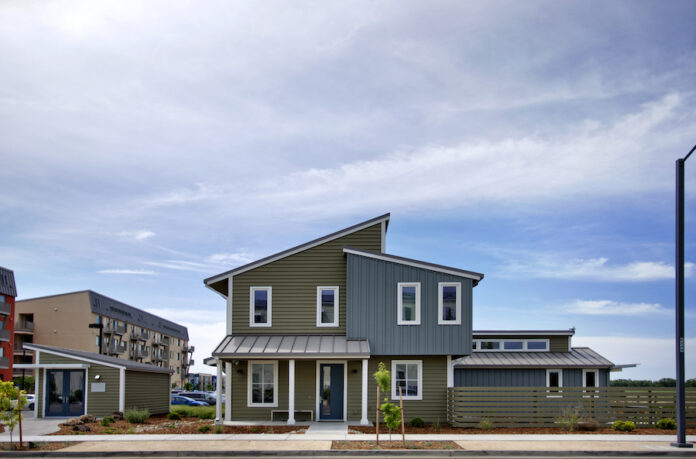A construction technology partially developed at UC Davis is being used to seal buildings and make them more energy-efficient.
Anyone who experienced the haze of smoke that descended on Northern California during the Camp Fire last year understands the benefits of an airtight building. When a structure doesn’t eak, the air quality inside can be closely regulated, and the building can be heated and cooled more efficiently. Because of these benefits, homeowners and developers demand that buildings be airtight. Finding and patching tiny leaks in a complex structures, however, can be a fool’s errand. In many cases, builders must spend hours searching for tiny leaks. A new technology called Aerobarrier, partially developed at UC Davis, could change the way leaks are identified and sealed.
With the Aerobarrier process, a blower fan is used to pressurize a structure, and then an aerosol sealant is sprayed inside the building which fills small leaks with a permanent seal. The process is quick and can fill gaps that workers cannot find, producing an incredibly airtight structure.
Aerobarrier is the successor to a technology called Aeroseal which is used to seal duct systems. Both products were developed by Mark Modera, a UC Davis engineering professor who is also the director of the Western Cooling and Efficiency Center. Aeroseal was initially developed by Modera when he worked at Lawrence Berkeley National Laboratory in 1994. Modera and his research team had done research demonstrating that leaky air duct systems waste a lot of energy. Manually sealing the systems could save energy, but it was time-intensive and difficult to do. Modera and his team set to work to find a technological solution to the problem.
“I found little robots that would go through a tape the insides of the ducts of a pipe, I found things that were used for sewer pipes, but then I had the idea based upon something I saw in the newspaper about using aerosols,” Modera said. “The newspaper said they sprayed the stuff in the ductwork to get rid of dust mites, and then it said; by the way it also seals the leaks.”
Modera invited the people who were using the aerosols to his lab but since the aerosols didn’t work as advertised, Modera and a graduate student worked for three years to develop an aerosol sealing technology that would. The product they came up with was called Aeroseal that uses pressure to distribute a sealant sprayed in a duct system. According to Modera, the pressure difference between the inside and outside of a duct system causes the particles to accumulate at the site of the leaks in the system and clog the gap.
“The air goes to make the turn to go out through the leak, and because you maintain the pressure difference between inside the duct and outside, that determines the velocity,” Modera said. “So it’s a high velocity and it’s a sharp turn, so the particle basically skids out and smashes into the side of the leak.”
Since the launch of Aeroseal in 1997, the technology has been used to seal upwards of 200,000 houses and won numerous industry awards. After the success of the company, Modera realized that the technology could be adapted to seal houses.
Buildings are more complicated to seal than air ducts but the principles are the same. The Aerobarrier technology works alongside a common air tightness test called the blower door test that is required to meet building codes in many states. To complete the test, a fan attached to the door of a building depressurizes the building, and then sensors measure how much air leaks in. With Aerobarrier, the fan is reversed to pressurize the building, and then sealant is sprayed inside and delivered to gaps in the building envelope by positive pressure. The tightness of the building is measured in air changes per hour. Most requirements dictate that buildings be under three or five air changes per hour which can be a challenge to meet by manual sealing leaks. Aerobarrier can get a building below one air change per hour and has even even gotten some buildings down to .19 air changes per hour.
While in development, Aerobarrier was tested at the Honda Smart Home, a house located in West Village that was built to demonstrate energy-efficient technologies. When the home was built six years ago, an early iteration of Aerobarrier was used to help seal the house and make it airtight. According to Michael Koenig, the director of the Honda Smart Home project, they chose to use the technology because they wanted greater control over the air quality in the house, and wanted to heat it and cool it as efficiently as possible.
“We didn’t want air to just move through walls and cavity spaces and under sills, because it will intrinsically be less clean, than if we bring in nice clean dry air and run it through a filter,” Koenig said. “Reducing the amount of infiltration and using mechanical ventilation is part of our energy reduction strategy.”
After applying the technology twice, they were able to increase the air tightness of the building fivefold.
Last year the product launched commercially, and has been widely adopted according to company data.
“We will soon have almost 50 installers in the marketplace across North America,” said Paul Springer, the head of Business Development at the company. “We’ll have an annual run rate of seals of around 4000 homes, by the end of this year.”
Written by: Peter Smith – science@theaggie.org




